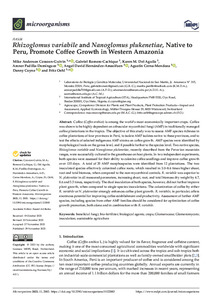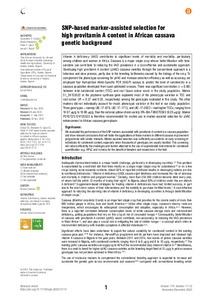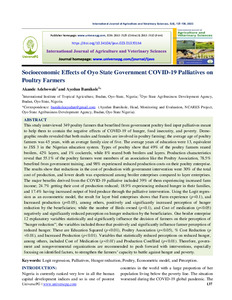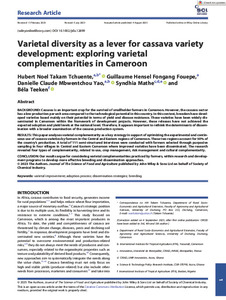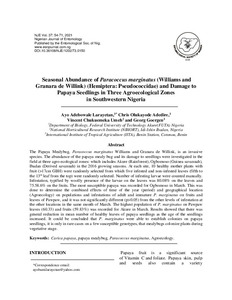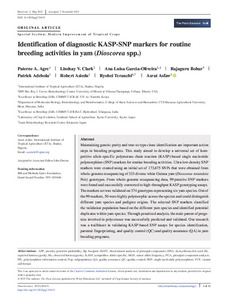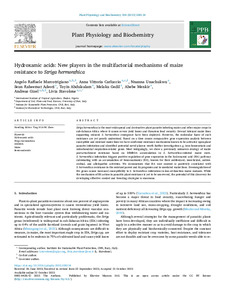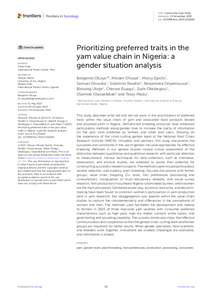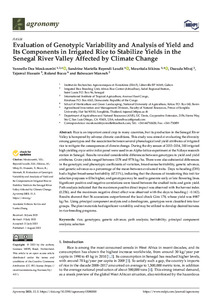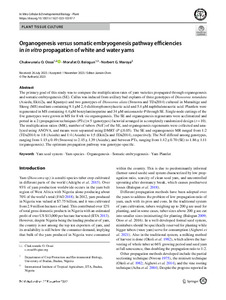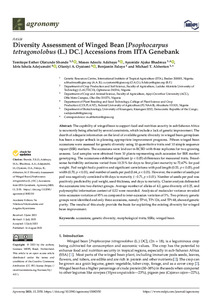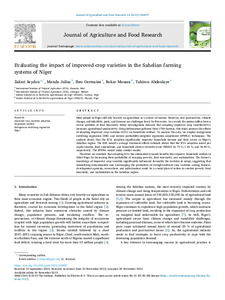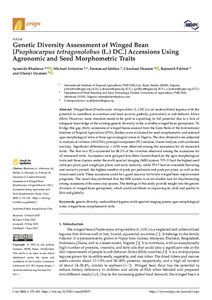Welcome to the International Institute of Tropical Agriculture Research Repository
Journal and Journal Articles: Recent submissions
Now showing items 181-200 of 5279
-
Smallholder aquaculture diversifies livelihoods and diets thus improving food security status: evidence from northern Zambia
(2024-01-05)Much has been made of the potential for aquaculture to improve rural livelihoods and food and nutrition security in Africa, though little evidence exists to back such claims. This study, conducted in northern Zambia, assessed the benefits of adopting aquaculture by comparing a sample of households with (n = 177) and without fishponds (n = 174). -
Rhizoglomus variabile and Nanoglomus plukenetiae, native to Peru, promote coffee growth in Western Amazonia
(2023-11-29)Coffee (Coffea arabica) is among the world’s most economically important crops. Coffee was shown to be highly dependent on arbuscular mycorrhizal fungi (AMF) in traditionally managed coffee plantations in the tropics. The objective of this study was to assess AMF species richness in coffee plantations of four provinces in Perú, to isolate AMF isolates native to these provinces, and to test the effects of selected indigenous AMF strains on coffee growth. AMF species were identified by morphological ... -
Morphometric diversity of some Nigerian accessions of Bambara groundnut (Vigna subterranea)
(2023)This study evaluated the morphological diversity of some Nigerian accessions of Bambara groundnut. Field experiments were conducted in Nigeria in two locations and the phenotypic variation of Bambara groundnut accessions evaluated in 3 years (2017–2020) using a randomized complete block design. Twenty-eight quantitative and 10 qualitative traits were observed. Twenty-three out of the 28 quantitative morphological traits showed significant differences. TVSu-589 (28.85) and TVSu-670 (28.57) had the ... -
Heterogeneity in arbuscular mycorrhizal fungi and plant communities of the Brazilian Cerrado, transitional areas toward the Caatinga, and the Atlantic forest
(2024-01-08)The Cerrado is the most diverse tropical savanna worldwide and the second-largest biome in South America. The objective of this study was to understand the heterogeneity and dynamics of arbuscular mycorrhizal fungi (AMF) in different types of natural Cerrado vegetation and areas that are transitioning to dryer savannas or tropical rainforests and to elucidate the driving factors responsible for the differences between these ecosystems. Twenty-one natural sites were investigated, including typical ... -
Sources of genetic resistance to Fusarium wilt (Fusarium oxysporum f. sp tracheiphilum) in cowpea (Vigna unguiculata (L.) Walp.) and comparison of inoculum concentration levels
(2023-12-09)Fusarium wilt caused by Fusarium oxysporum f. sp tracheiphilum (Fot) is a soil-borne fungal disease of significant constraint to cowpea production in West Africa. The disease infection can cause up to 100% yield loss in highly infested fields. The most effective control strategy is the use of resistant varieties. Sixty cowpea germplasm collections were screened for resistance to F. oxysporum. The result revealed that only two (TVu 134 and TVu 410) of the germplasm showed a high level of resistance ... -
SNP-based marker-assisted selection for high provitamin A content in African cassava genetic background
(2023-12)Vitamin A deficiency (VAD) contributes to significant levels of mortality and morbidity, particularly among children and women in Africa. Cassava is a major staple crop whose biofortification with beta-carotene can contribute to reducing the VAD prevalence in a cost-effective and sustainable approach. Developing high provitamin A content (pVAC) cassava varieties through the conventional approach is a laborious and slow process, partly due to the breeding bottlenecks caused by the biology of the ... -
Socioeconomic effects of Oyo state government COVID-19 palliatives on poultry farmers
(2023)This study interviewed 349 poultry farmers that benefited from government poultry feed input palliatives meant to help them to contain the negative effects of COVID-19 of hunger, food insecurity, and poverty. Demographic results revealed that both males and females are involved in poultry farming; the average age of poultry farmers was 45 years, with an average family size of five. The average years of education were 13, equivalent to JSS 3 in the Nigerian education system. Types of poultry show ... -
Varietal diversity as a lever for cassava variety development: exploring varietal complementarities in Cameroon
(2023)BACKGROUND: Cassava is an important crop for the survival of smallholder farmers in Cameroon. However, the cassava sector has a low production per unit area compared to the technological potential in this country. In this context, breeders have developed varieties based mainly on their potential in terms of yield and disease resistance. These varieties have been widely disseminated in Cameroon within the framework of development projects. However, these releases have not achieved the expected ... -
Seasonal abundance of Paracoccus marginatus (Williams and Granara de Willink) (Hemiptera: Pseudococcidae) and damage to papaya seedlings in three agroecological zones in Southwestern Nigeria
(2021)The Papaya Mealybug, Paracoccus marginatus Williams and Granara de Willink, is an invasive species. The abundance of the papaya mealy bug and its damage to seedlings were investigated in the field at three agro-ecological zones: which includes Akure (Rainforest), Ogbomoso (Guinea savannah), Ibadan (Derived savannah) in the 2016 growing seasons. At each site, 10 healthy mother plants with fruit (> 17cm GBH) were randomly selected from which five infested and non-infested leaves (fifth to the 13th ... -
Identification of diagnostic KASP-SNP markers for routine breeding activities in yam (Dioscorea spp.)
(2023)Maintaining genetic purity and true-to-type clone identification are important action steps in breeding programs. This study aimed to develop a universal set of kompetitive allele-specific polymerase chain reaction (KASP)-based single nucleotide polymorphism (SNP) markers for routine breeding activities. Ultra-low-density SNP markers were created using an initial set of 173,675 SNPs that were obtained from whole-genome resequencing of 333 diverse white Guinea yam (Dioscorea rotundata Poir) genotypes. ... -
Hydroxamic acids: New players in the multifactorial mechanisms of maize resistance to Striga hermonthica
(2023-11)Striga hermonthica is the most widespread and destructive plant parasite infesting maize and other major crops in sub-Saharan Africa where it causes severe yield losses and threatens food security. Several tolerant maize lines supporting reduced S. hermonthica emergence have been deployed. However, the molecular bases of such resistance are yet poorly understood. Based on a time course comparative gene expression analysis between susceptible and resistant maize lines we have confirmed resistance ... -
Prioritizing preferred traits in the yam value chain in Nigeria: a gender situation analysis
(2023-11-13)This study describes what did and did not work in the prioritization of preferred traits within the value chain of yam and associated food products (boiled and pounded yam) in Nigeria. Demand-led breeding protocols have enhanced participatory methods along gender lines to increase the clarity of information on the yam traits preferred by farmers and other end users. Drawing on the experience of the cross-cutting gender team at the National Root Crops Research Institute (NRCRI), Umudike, and partners, ... -
Evaluation of genotypic variability and analysis of yield and its components in irrigated rice to stabilize yields in the Senegal river valley affected by climate change
(2023)Rice is an important cereal crop in many countries, but its production in the Senegal River Valley is hampered by adverse climatic conditions. This study was aimed at evaluating the diversity among genotypes and the association between several phenological and yield attributes of irrigated rice to mitigate the consequences of climate change. During the dry season of 2013–2014, 300 irrigated high yielding oryza sativa indica panel were used in an Alpha-lattice experiment at the Ndiaye research ... -
Entrepreneurial and attitudinal determinants for adoption of Climate-smart Agriculture technologies in Uganda
(2023)Climate-Smart Agriculture (CSA) technologies have great potential to minimize climate risks, sequester carbon, improve food security, and achievement of Sustainable Intensification (SI) goals. This makes their adoption a necessity for achieving sustainable agricultural systems. Despite the benefits and all efforts, smallholder farmers in developing countries still have low adoption of CSA technologies. This study explored the determinants of intentions to start and continue adopting CSA technologies. ... -
Targeted knockout of early nodulin-like 3 (MusaENODL3) gene in banana reveals its function in resistance to Xanthomonas wilt disease
(2023-11-28)Nodulins and nodulin-like proteins play an essential role in the symbiotic associations between legumes and Rhizobium bacteria. Their role extends beyond the leguminous species, as numerous nodulin-like proteins, including early nodulin-like proteins (ENODL), have been identified in various non-leguminous plants, implying their involvement in functions beyond nodulation, such as nutrient transport and growth modulation. Some ENODL proteins have been associated with plant defense against pathogens, ... -
Organogenesis versus somatic embryogenesis pathway efficiencies in in vitro propagation of white and water yams
(2023)The primary goal of this study was to compare the multiplication rates of yam varieties propagated through organogenesis and somatic embryogenesis (SE). Callus was induced from axillary bud explants of three genotypes of Dioscorea rotundata (Asiedu, Ekiti2a, and Kpamyo) and two genotypes of Dioscorea alata (Swaswa and TDa2014) cultured in Murashige and Skoog (MS) medium containing 9.1 µM 2,4-dichlorophenoxylacetic acid and 5.4 µM naphthaleneacetic acid. Plantlets were regenerated in MS containing ... -
Gender differentiation on the determinants and intensity of adoption of Purdue improved cowpea storage (PICS) bags in Northern Nigeria
(2023-11-29)Postharvest and storage of agricultural produce such as cowpea remains a significant challenge in sub-Sahara Africa. This study assessed gender differentiation on the determinants and intensity of adoption of Purdue-improved cowpea storage (PICS) bags in northern Nigeria. Primary data was collected via a well-questionnaire from Kano, Kaduna, Gombe, Bauchi, Plateau, and the Niger States. Each State was purposively selected based on the concentration and availability of female PICS bag users. From ... -
Diversity assessment of winged bean [Psophocarpus tetragonolobus (L.) DC.] accessions from IITA Genebank
(2023)The capability of winged bean to support food and nutrition security in sub-Saharan Africa is recurrently being affected by several constraints, which include a lack of genetic improvement. The dearth of adequate information on the level of available genetic diversity in winged bean germplasm has been a major setback in planning appropriate improvement programs. Fifteen winged bean accessions were assessed for genetic diversity using 10 quantitative traits and 10 simple sequence repeat (SSR) ... -
Evaluating the impact of improved crop varieties in the Sahelian farming systems of Niger
(2023-12)Most people in Niger still rely heavily on agriculture as a source of income. However, low productivity, climate change, soil infertility, pests, and diseases are challenges faced by this sector. As a result, the nation suffers from a severe problem of food insecurity. Many investigations indicate that adopting improved crop varieties(ICVs) increases agricultural productivity. Using information gathered from 1784 farmers, this study assesses the effects of adopting improved crop varieties (ICVs) ... -
Genetic diversity assessment of winged bean [Psophocarpus tetragonolobus (L.) DC.] accessions using agronomic and seed morphometric traits
(2023)Winged bean [Psophocarpus tetragonolobus (L.) DC.] is an underutilized legume with the potential to contribute to nutrition and food security globally, particularly in sub-Saharan Africa (SSA). However, more attention needs to be paid to exploiting its full potential due to a lack of adequate knowledge of the existing genetic diversity in the available winged bean germplasm. To bridge this gap, thirty accessions of winged beans sourced from the Gene Bank of the International Institute of Tropical ...


